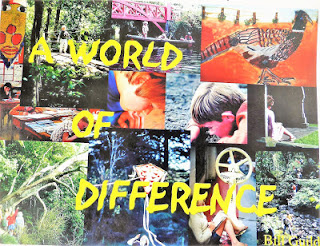Education Readings
Introduction to
readings
It would seem many
schools are still locked into the assessment and associated documentation
required by National Standards and as a result are dedicating too much of their
time to literacy and numeracy – as important as they are. Bruce and I
have long believed that the most important thing is to expose students to a
rich thinking curriculum – a curriculum that integrates areas
of the curriculum
as required. Nothing new in this. Elwyn Richardson in his wonderful book In theEarly World (available NZCER) written in the 60s saw his students as a
community of artists and scientists exploring their environment and their personal concerns. More recently
Professor Peter O’Conner has expressed the need to develop programmes to
develop student creativity (November 2018 NZPF Magazine) and quoted John Dewey,
‘the arts are tools by which we train the imagination…its only when we imagine
that we can be better, that we can really change’.
Time now for some
creativity and imagination in our schools.
Allan Alach
Bruce Hammond
Innovative
Learning Environments – where’s the evidence?
‘In an open letter to Education Minister Chris Hipkins, parent Kia
King outlines her concerns that there is no evidence to show that innovative
learning environments can support enhanced teaching and learning.’
Innovative
Learning Environments – here’s the evidence
 ‘Educational Consultant and Director of Leading Learning Mark Osborne
responds to two big questions: Why is the design of classrooms changing? And
how can we be sure that ‘innovative learning environments’ are actually leading
to better teaching and learning?’
‘Educational Consultant and Director of Leading Learning Mark Osborne
responds to two big questions: Why is the design of classrooms changing? And
how can we be sure that ‘innovative learning environments’ are actually leading
to better teaching and learning?’
Inside an ‘Innovative
Learning Environment – for and against
‘One of the great advantages touted is that ILEs create
collaborative
teaching. Staff, from the same or different departments, must work together.
They share the space. There are no walls, every move is under examination not
only by their students but also by their peers. It’s the complete
deprivatisation of practice. Proponents say that it allows weaker practitioners
to learn from their stronger counterparts - to observe teaching techniques and
behaviour management in action.’ Others have their doubts.
Tomorrow's
Schools Review: Winner vs Loser Schools!
 |
| Maurie Abrahams |
‘One innovative principal’s view. ‘I have been emotionally shaken by what I heard about the
willingness of some school leaders to adopt the position that everything is OK
for us so leave it as it is! So much so that I carefully chose the discussion
tables I went to so that I could avoid hearing this position being promoted. I
failed!Yet, despite that experience I still feel optimistic. The generational
shift occurring across many professions and institutions will not bypass
education and school leadership.’ By Maurie Abrahams - Hobsonville Point School
What Makes a Good
School Culture?
 ‘Most principals have an instinctive awareness that organizational
culture is a key element of school success. They might say their school has a “good
culture” when teachers are expressing a shared vision and students are
succeeding — or that they need to “work on school culture” when several
teachers resign or student discipline rates rise. But like many organizational
leaders, principals may get stymied when they actually try to describe the
elements that create a positive culture.’
‘Most principals have an instinctive awareness that organizational
culture is a key element of school success. They might say their school has a “good
culture” when teachers are expressing a shared vision and students are
succeeding — or that they need to “work on school culture” when several
teachers resign or student discipline rates rise. But like many organizational
leaders, principals may get stymied when they actually try to describe the
elements that create a positive culture.’
Russell Bishop:
Who’s to blame for Māori failures at school?
 |
| Russell Bishop |
‘In 1998, I wrote a book Culture Counts, where I suggested that the
most important thing teachers could do, before they could do the job of
teaching, was to establish figurative whakapapa-type relationships with Māori
students and their families. This would let the students and their families
know that you were serious and in your classroom, Māori could succeed. That’s
what was missing from the schools and the classrooms where Māori kids weren’t
achieving at the level they should — a base of whanaungatanga.’
The Artistry of
Teaching
‘There is one
goal [of education] that, if not achieved, makes the
achievement of all other
goals very unlikely. That goal is to create those conditions that make students
want to learn; not have to learn but want to learn more about self, others, and
the world. The overarching purpose of schooling and its governance is to
support that goal, i.e., to create and sustain contexts of productive learning
supportive of the natural curiosity and wonder with which children start
schooling.’ Seymour Sarason
 |
| Seymour Saraon |
Imagination,
Inquiry, and Agency
‘Finish this sentence…“Imagine a place where students could…”Is that
place your school? What would it take for that place to be a reality for your
students? What do you think school could, and should be? That question is the
focus of thousands of conversations in school communities today. It’s a sign of
the concern, the angst, and for some even the desperation to better understand
how we can more relevantly prepare our students for the rapidly changing modern
world we all now live in.’
Article: ‘If all
of that testing had been improving us, we would have been the highest-achieving
nation in the world.' Here’s what does work in school reform
‘So what should
this country be doing to improve public schools? For one thing, pay attention
to the social and emotional needs of students so that they are prepared to
tackle academic work at school, Darling-Hammond said. Darling-Hammond cited
these policies in high-performing countries: Equitable resources to schools.
Major investments in educator preparation and ongoing support Schools designed
to support teacher and student learning. Equitable access to a rich, thinking
curriculum. Performance assessments focused on higher order skills that are
used to guide learning.’
5 reasons why
data is a waste of everyone's time
‘Why do we put so
much focus on data? It's unreliable, confuses pupils and teachers, and takes up
far too much time, writes one teacher.’
Simple Tips for
Boosting Teacher Resilience
‘Try these quick
and easy ways to build resilience and relieve stress.’
By Alfie Kohn
‘But as I’ve
thought more carefully about scaffolding — and watched as it, like so many
other promising terms, has been appropriated by non- and even anti-progressive
educators – I’ve become increasingly skeptical. Here are some questions I think
we might want to ask when the word is casually tossed around.’
http://bit.ly/2XGKXyd
A couple of Bruce’s Oldies
Transforming
Secondary Education – the most difficult challenge of all. Thoughts from a past
age – ‘Young Lives at Stake’ by Charity James
 ‘Charity James believed it was important to get secondary education
right if all students were to leave able to take advantage of the exciting
opportunities the future might offer.
The challenge remains. Secondary schools need a radical reappraisal to
ameliorate the effects of obvious social and cultural disadvantages and also to
develop the needs, talents and gifts of all students.’
‘Charity James believed it was important to get secondary education
right if all students were to leave able to take advantage of the exciting
opportunities the future might offer.
The challenge remains. Secondary schools need a radical reappraisal to
ameliorate the effects of obvious social and cultural disadvantages and also to
develop the needs, talents and gifts of all students.’
'A World of
Difference’: the philosophy of a Taranaki pioneer creative teacher - Bill Guild
‘The ideas that Bill developed 1970- 1986 may be useful for today's
teachers and they return their focus to developing students creativity and
imagination.’










No comments:
Post a Comment